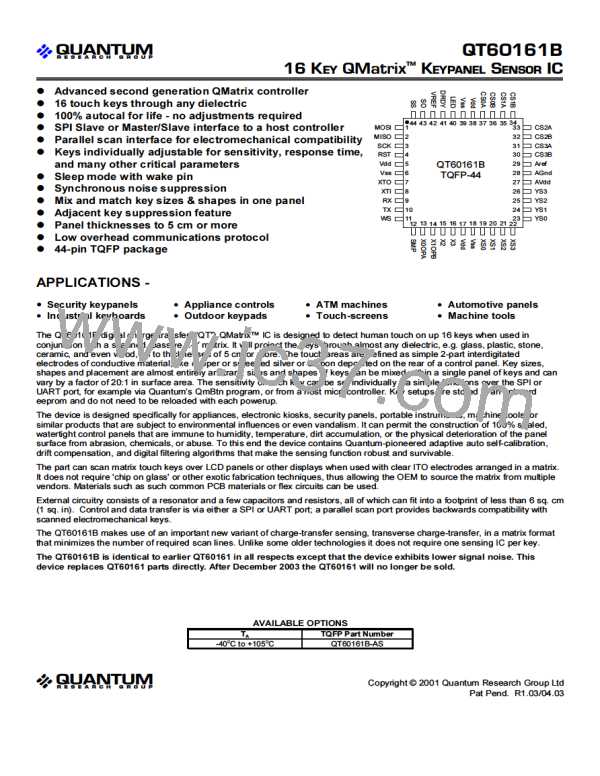©Quantum Research Group Ltd.
It is important that burst spacings be verified on an
5.7 Timing Limitations
oscilloscope with an actual keymatrix during development to
be certain that the device timings are preserved and are
constant. If not, the burst length and/or pulse spacing should
be reduced.
The device requires processing time between bursts, as well
as time to handle communications with the host. With short
burst spacings, long burst lengths, and long intra-burst pulse
spacings, the device can simply run out of available
processing time. When this happens, burst timing and host
communications slow down and become erratic.
Table 5-2 Permissible Burst Lengths (BL’s)
Cs = 4.7nF, Cx = 5pF, Rs = 180K; 100µs ramp time
Pulse Spacing = 2µs
Pulse Spacing = 3µs
Pulse Spacing = 4µs
Pulse Spacing = 5µs
Pulse Spacing = 6µs
Burst
Burst
Spacing
500
Burst
Burst
Spacing
500
Burst
Max BL
Spacing
Max BL
Max BL
Spacing
Max BL
Max BL
Spacing
500
1,000
2,000
64
64
64
64
64
64
500
1,000
2,000
50
64
64
40
64
64
500
1,000
2,000
30
64
64
1,000
2,000
1,000
2,000
Pulse Spacing = 7µs
Pulse Spacing = 8µs
Pulse Spacing = 9µs
Pulse Spacing = 10µs
Burst
Burst
Burst
Burst
Max BL
Spacing
Max BL
Spacing
Max BL
Spacing
Max BL
Spacing
500
30
50
64
500
25
50
64
500
20
40
64
500
20
40
64
1,000
2,000
1,000
2,000
1,000
2,000
1,000
2,000
5.8 Erratta / Notes
4 April 2003 - The QT60xx5 version 1.05 datasheet erroneously showed negative recalibration timeouts in the range from
1..255 seconds. The correct range is 0.1..25.5 seconds. From datasheet version 1.06 on, this document change has been
made. The devices themselves are not affected.
lQ
30
www.qprox.com QT60161B / R1.03

 QUANTUM [ QUANTUM RESEARCH GROUP ]
QUANTUM [ QUANTUM RESEARCH GROUP ]